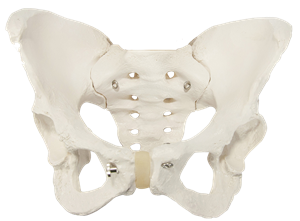PDF chapter test TRY NOW
Axial skeleton
1. Skull:

Skull
The skull is a structure that is made up of many bones known as cranial and facial bones joined together to enclose and protect the brain. It is also known as the cranium or brain box.
2. Vertebral column:

Vertebral column
It is also known as the backbone. It consists of many small bones called vertebrae that are 33 in number. A person can bend over only due to the presence of this bone.
Functions of the vertebral column:
- It is the structure that protects the spinal cord.
- It supports the head.
- It is a structure that serves as an attachment for the ribs.
- It provides support and serves as a place of attachment for the pectoral and pelvic girdle.
- It is responsible for the movement of human skeleton.
- It aids during walking and standing erect with the correct posture.
3. The chest bones:

Rib cage 
The cone-shaped structure that occupies the chest region and is also known as the rib cage. There are 12 ribs on each side of the chest that are joined to the central chest bone and the backbone. The ribcage is set up in such a way so that it can contract and expand during the process of breathing. The ribcage protects the underlying lungs, heart and some part of the liver.
Appendicular skeleton:
1. Shoulder bone or pectoral bone:

Pectoral bone
The collar bone at the front and the shoulder blade at the back together form the shoulder bone. The breast bone and the shoulder blade supports the collar bone at the ends. The shoulder bone is the place where the ball and socket joint is found as here the shoulder bone encloses a socket like cavity into which fixes the ball of the upper arm. This girdle is also known as the pectoral girdle.
2. Bones of the arm:

Bones of the upper limb
It is the upper limb that is made up of bones such as humerus, radius, ulna, carpals, metacarpals and phalanges that are joined by the hinge joints which allow the limb to move only in one direction.
Humerus is the bone that makes the bone makes the upper arm, the radius and ulna make up the fore-arm. The carpals are the bones that make up the wrist, metacarpals make up the palm and the phalanges make up the fingers.
3. Pelvic bone:

Pelvic girdle
It is also known as the pelvic girdle. It is a structure that encloses the portion of the body below the stomach. A person can sit only because of this bone. This is a structure that is made up of strong bones so that the entire weight of the body can be balanced.
Important!
Some of the other structures included in the skeletal system are the Cartilage and the muscle.
The soft structure found in between the joints of the skeleton and the upper portion of the ear lobe is known as a Cartilage.
The soft contractile tissue that is attached to the bones is known as Muscle.
The soft structure found in between the joints of the skeleton and the upper portion of the ear lobe is known as a Cartilage.
The soft contractile tissue that is attached to the bones is known as Muscle.
Reference:
https://upload.wikimedia.org/wikipedia/commons/1/14/Figure_38_01_11.jpg
https://en.wikipedia.org/wiki/Shoulder_girdle#/media/File:Pectoral_girdle_front_diagram.svg
